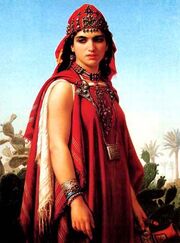Kahina or al-Kahina was a 7th century female Berber military leader who took the lead in her people's resistance to Arab expansion in Numidia (Maghreb), Northwest Africa. She was also known as Damiya and al-Kahinat and was the daughter of Matiya.
The successor to Kusaila in the 680s, she opposed encroaching Arab armies led by Hasan ibn al-Nu'man who had successfully captured Carthage. Receiving word of a "queen of the Berbers" who was the most powerful ruler in North Africa, he decided to march into Numidia. The armies met near Meskiana, Algeria. Hasan was defeated by Kahina and he fled to Libya and remained there for four or five years. Not wanting to take her victory for granted, she decided on a "scorched earth" campaign in case al-Nu'man decided to come back. (A scorched earth campaign is a military strategy which involves destroying anything that might be useful to the enemy while advancing through or withdrawing from the area.) Unfortunately, this angered the neighboring peoples of the area and had little impact upon the enemy.
Hasan eventually returned and through a prisoner of war of Kahina's camp, defeated her. It was said that Kahina died in battle or that she committed suicide by swallowing poison so that she didn't have to surrender to the enemy.
Legends About Kahina[]
Many legends are spoken about Kahina, the most famous being that she had the ability to foresee the future. She was very tall with long hair and may have even lived to be 127. In her youth she had agreed to marry a tyrant in order to free her people, then murdered him on their wedding night.
She may have been of mixed descent. She was Berber and Byzantine. However Berber may not have been her only tribe. Some Middle Eastern Scholars believed that she was also a member of the Luwata or Jrawa tribe and dwelled in the Aures Mountains.
About Her People[]
The name Berber comes from the Greek word "barbar" or barbarian but the Berbers refer to themselves as Amazigh (Amazon?) meaning "free people". They originally dwelled in North Africa west of the Nile River but today live in places as diverse as Morocco, Algeria, Libya, Mali and Niger. They speak Berber, Darija, French, some Spanish and Arabic.
Women in Amazigh society held higher status than their Arabic counterparts so it comes as no surprise that Kahina would be chosen as the next in line to rule the Berbers.

"Berber Woman" by Emile Vernet-Lecomte. Oil on canvas 1870.
